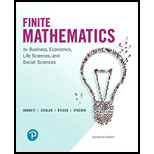
In Problems 49-64, construct a mathematical model in the form of a linear programming problem. (The answers in the back of the book for these application problems include the model.) Then solve by the geometric method.
Nutrition. A dietician is to arrange a special diet composed of two foods,
Want to see the full answer?
Check out a sample textbook solution
Chapter 5 Solutions
Finite Mathematics for Business, Economics, Life Sciences and Social Sciences
Additional Math Textbook Solutions
Basic Business Statistics, Student Value Edition
Calculus: Early Transcendentals (2nd Edition)
University Calculus: Early Transcendentals (4th Edition)
Pre-Algebra Student Edition
A First Course in Probability (10th Edition)
Elementary Statistics: Picturing the World (7th Edition)
- 22 Bob decides that after his heart attack is a good time to get in shape, so he starts exer- cising each day and plans to increase his exercise time as he goes along. Look at the two line graphs shown in the following fig- ures. One is a good representation of his data, and the other should get as much use as Bob's treadmill before his heart attack. Exercise time 40 Line Graph 1 of Exercise Log 35 30- 25 201 20 Exercise time 80 80 60 40- 1 10 20 30 30 40 50 60 Day 170 50 80 Line Graph 2 of Exercise Log 1 10 20 90 100 30 30 40 50 60 70 80 90 100 Day a. Compare the two graphs. Do they repre- sent the same data set, or do they show totally different data sets? b. Assume that both graphs are made from the same data. Which graph is more appropriate and why?arrow_forward8 Suppose that a small town has five people with a rare form of cancer. Does this auto- matically mean a huge problem exists that needs to be addressed?arrow_forward1 M&Ms colors come in the following percent- ages: 13 percent brown, 14 percent yellow, 13 percent red, 24 percent blue, 20 percent orange, and 16 percent green. Reach into a bag of M&Ms without looking. a. What's the chance that you pull out a brown or yellow M&M? b. What's the chance that you won't pull out a blue? swarrow_forward
- 11. Prove or disprove: (a) If is a characteristic function, then so is ²; (b) If is a non-negative characteristic function, then so is √√4.arrow_forward17. [-/1 Points] DETAILS MY NOTES SESSCALCET2 6.2.050. Evaluate the integral. (Remember to use absolute values where appropriate. Use C for the constant of integration.) du 4√3- -4² Need Help? Read It SUBMIT ANSWER 18. [-/1 Points] DETAILS MY NOTES SESSCALCET2 6.2.051. Evaluate the integral. (Use C for the constant of integration.) - 49 dx x² +3 Need Help? Read It Watch It SUBMIT ANSWER 19. [-/1 Points] DETAILS MY NOTES SESSCALCET2 6.2.057. Evaluate the integral. (Remember to use absolute values where appropriate. Use C for the constant of integration.) 25+ x2 dxarrow_forwardLet (5,3,-7) and = (2, -3, -6). = Compute the following: u× u = -4(u xv) ux (-4v) (+v) × v=arrow_forward
- Let a = (4, -2, -7) and 6 = (2,5, 3). (ã − ò) × (ã + b) =arrow_forward4. Suppose that P(X = 1) = P(X = -1) = 1/2, that Y = U(-1, 1) and that X and Y are independent. (a) Show, by direct computation, that X + Y = U(-2, 2). (b) Translate the result to a statement about characteristic functions. (c) Which well-known trigonometric formula did you discover?arrow_forward9. The concentration function of a random variable X is defined as Qx(h) = sup P(x ≤ X ≤x+h), h>0. x (a) Show that Qx+b (h) = Qx(h). (b) Is it true that Qx(ah) =aQx(h)? (c) Show that, if X and Y are independent random variables, then Qx+y (h) min{Qx(h). Qy (h)). To put the concept in perspective, if X1, X2, X, are independent, identically distributed random variables, and S₁ = Z=1Xk, then there exists an absolute constant, A, such that A Qs, (h) ≤ √n Some references: [79, 80, 162, 222], and [204], Sect. 1.5.arrow_forward
- 29 Suppose that a mound-shaped data set has a must mean of 10 and standard deviation of 2. a. About what percentage of the data should lie between 6 and 12? b. About what percentage of the data should lie between 4 and 6? c. About what percentage of the data should lie below 4? 91002 175/1 3arrow_forward2,3, ample and rical t? the 28 Suppose that a mound-shaped data set has a mean of 10 and standard deviation of 2. a. About what percentage of the data should lie between 8 and 12? b. About what percentage of the data should lie above 10? c. About what percentage of the data should lie above 12?arrow_forward27 Suppose that you have a data set of 1, 2, 2, 3, 3, 3, 4, 4, 5, and you assume that this sample represents a population. The mean is 3 and g the standard deviation is 1.225.10 a. Explain why you can apply the empirical rule to this data set. b. Where would "most of the values" in the population fall, based on this data set?arrow_forward
 Algebra for College StudentsAlgebraISBN:9781285195780Author:Jerome E. Kaufmann, Karen L. SchwittersPublisher:Cengage Learning
Algebra for College StudentsAlgebraISBN:9781285195780Author:Jerome E. Kaufmann, Karen L. SchwittersPublisher:Cengage Learning College Algebra (MindTap Course List)AlgebraISBN:9781305652231Author:R. David Gustafson, Jeff HughesPublisher:Cengage Learning
College Algebra (MindTap Course List)AlgebraISBN:9781305652231Author:R. David Gustafson, Jeff HughesPublisher:Cengage Learning

